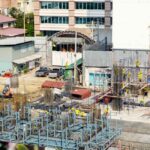This website uses cookies so that we can provide you with the best user experience possible. Cookie information is stored in your browser and performs functions such as recognising you when you return to our website and helping our team to understand which sections of the website you find most interesting and useful.

Streamlining Mall Building Permits for Project Success

Understanding Zoning Permits
When embarking on mall construction, understanding the nuances of zoning permits is crucial. These permits play a foundational role in the mall development process, ensuring that the proposed construction aligns with municipal regulations and land-use plans.
Importance of Zoning Permits
Zoning permits or Mall Building Permits are essential for maintaining order and organization within a municipality. They designate specific areas for residential, commercial, and industrial use, preventing incompatible developments, such as shopping centers or noisy manufacturing plants, from encroaching on residential neighborhoods. For instance, a C3 zoning classification is typically reserved for heavy commercial use, which can include shopping malls or mixed-use buildings in some cities (Lev).
A zoning permit grants permission to construct a new building or make changes to an existing structure, even if it involves a change in use. For example, converting a residential house into a small office building requires a zoning permit. It’s a legal requirement that ensures proposed developments adhere to designated land-use policies, thus fostering a well-organized urban environment.
| Type of Zoning | Purpose |
|---|---|
| Residential | Housing and related services |
| Commercial | Shopping centers, offices, and retail |
| Industrial | Factories, warehouses, and heavy commercial use |
Process of Obtaining Zoning Permits

Acquiring a zoning permit is the first step in the building process for commercial real estate development and must be done before applying for a building permit. The process involves a relatively simple three-step procedure:
- Filling Out the Application Form: The applicant needs to complete an application form, providing details about the proposed construction project.
- Submitting Completed Paperwork: Along with the application form, the applicant must submit supporting documents, such as site plans, architectural drawings, and any other relevant information.
- Paying the Filing Fee: A filing fee is required to process the application. The fee amount may vary depending on the municipality and the scope of the project.
Once the application is submitted, it goes through a review process. The outcome can be an approval, a rejection, or a request for a hearing if there are objections or additional considerations.
| Step | Description |
|---|---|
| 1 | Fill out the application form |
| 2 | Submit completed paperwork and supporting documents |
| 3 | Pay the filing fee |
Understanding the importance of zoning permits and the process of obtaining them is fundamental to ensuring a smooth and successful mall construction timeline. Properly navigating these initial steps lays a strong foundation for the entire development project, helping to avoid potential legal and regulatory setbacks. For more details on the economic impact and trends in building permit issuance, explore our section on the economic significance of building permits.
Impact of Building Permits
Economic Significance of Mall Building Permits

Building permits play a critical role in the economic landscape, influencing various sectors and driving growth in numerous ways. For mall construction, the issuance of building permits is vital for ensuring compliance with local regulations and facilitating the smooth execution of projects. Permits also contribute to local government revenues through fees, which can be reinvested into community infrastructure and services.
Building permits are a barometer of economic health, reflecting trends in construction activity and investment. They help mall developers and investors gauge the market’s vitality and make informed decisions regarding new projects. The significance of building permits extends to job creation, as construction projects typically generate employment opportunities for various trades and professions.
Trends in Building Permit Issuance
The trends in building permit issuance provide valuable insights into the construction industry’s current state and future outlook. In Canada, the total value of building permits decreased by 14.0% from November to December 2023, reaching $9.2 billion—the lowest monthly level since October 2020 (Statistics Canada). This decline was observed in both residential and non-residential sectors.
| Sector | November 2023 | December 2023 | Percentage Change |
|---|---|---|---|
| Residential Permits | $6.9 billion | $5.7 billion | -17.9% |
| Non-Residential Permits | $3.9 billion | $3.6 billion | -7.0% |
In the residential sector, the total value of permits fell by 17.9% to $5.7 billion in December 2023. This drop was primarily driven by a significant decline in multi-unit construction intentions, which saw a 31.1% decrease, amounting to a $1.3 billion reduction. Meanwhile, single-family dwelling permits experienced modest growth, edging up 0.8% to $2.9 billion. Notably, Alberta recorded a substantial increase of 15.3% (+$84.4 million) in single-family dwelling construction intentions, marking the highest monthly value since January 2014.
| Residential Permits | November 2023 | December 2023 | Percentage Change |
|---|---|---|---|
| Multi-Unit Construction | $4.2 billion | $2.9 billion | -31.1% |
| Single-Family Dwellings | $2.7 billion | $2.9 billion | +0.8% |
The non-residential sector also experienced a decline, with the total value of permits decreasing by 7.0% to $3.6 billion in December 2023. This decrease was significantly influenced by a 55.8% decline in institutional permits in Quebec (-$313.9 million), due to the absence of new major institutional permits issued in December (Statistics Canada).
| Non-Residential Permits | November 2023 | December 2023 | Percentage Change |
|---|---|---|---|
| Institutional Permits (Quebec) | $563.1 million | $249.2 million | -55.8% |
In the United States, the issuance of building permits also showed notable trends. In 2023, all states and the District of Columbia reported declines in single-family permits except for a few states, such as Hawaii (+16.7%), Maryland (+8.7%), and Nevada (+5.8%) (NAHB). The ten states issuing the highest number of single-family permits combined accounted for 63.9% of the total single-family permits issued.
| State | Change in Single-Family Permits (2023) |
|---|---|
| Hawaii | +16.7% |
| Maryland | +8.7% |
| Nevada | +5.8% |
| Texas | -6.5% |
| Florida | -6.9% |
For multifamily permits, 15 states recorded growth, while 35 states and the District of Columbia saw declines. Delaware led with a 96.3% increase in multifamily permits, while Wyoming experienced the greatest decline of 74.2%.
| State | Change in Multifamily Permits (2023) |
|---|---|
| Delaware | +96.3% |
| Wyoming | -74.2% |
| Texas | -24.0% |
| Florida | -12.4% |
| California | -3.4% |
Understanding these trends can help stakeholders in mall construction make informed decisions about investments and project planning. For more information on the mall development process, visit our article on the mall development process.
Building Permit Regulations
For successful mall projects, understanding building permit regulations is crucial. This section covers the reasons for denial of permits and the review process for obtaining them.
Reasons for Denial of Building Permits
Building permits for mall projects can be denied for several reasons. Common reasons include:
- Zoning Issues: If the proposed mall is in an area not zoned for commercial use, the permit will be denied. Zoning regulations are strict about the type of structures allowed in specific areas (Quora).
- Non-Conformance to Building Codes: The submitted plans must adhere to current building codes. If they do not meet the required standards, the permit application will be rejected.
- Lack of Essential Services: If the proposed site lacks essential services such as water supply, drainage, sewers, waste disposal, power lines, and road access, the permit will likely be denied (Quora).
- Community Standards: The materials used and the proposed use of the building must blend with the neighborhood. Subjective judgments by the zoning department can lead to denial if the project does not align with community standards.
Review Process for Building Permits
The review process for building permits involves several steps:
- Submission of Plans: Detailed plans must be submitted, outlining the proposed structure, location, and intended use. These plans are reviewed for compliance with zoning regulations and building codes.
- Zoning Department Review: The zoning department assesses the plans for conformity with zoning regulations, including:
- Building setback
- Percentage of lot coverage
- Parking availability
- Screening from neighboring properties
- Permitted uses within the zoning district
- Neighborhood blending and materials used
- Community and Environmental Impact: Additional reviews may be conducted to assess the impact on the community and environment. This includes ensuring the project does not adversely affect traffic, noise levels, and environmental sustainability.
- Permit Approval or Denial: After thorough review, the permit is either approved or denied. If denied, specific reasons are provided, and the applicant may need to revise and resubmit the plans.
| Step | Description |
|---|---|
| Submission of Plans | Detailed plans outlining the proposed structure, location, and intended use |
| Zoning Department Review | Assessment for compliance with zoning regulations and building codes |
| Community and Environmental Impact | Evaluation of the project’s impact on the community and environment |
| Permit Approval or Denial | Final decision based on the review, with reasons provided for any denial |
Understanding these regulations and the review process is essential for navigating the complexities of mall development. For more information on managing building permits effectively, visit our articles on mall construction companies and mall construction timeline.
Case Studies and Insights
Building Permit Trends in Specific Locations
Examining building permit trends in specific areas can offer valuable insights into the economic and developmental landscape, particularly for mall construction.
Sault Ste. Marie
Recent construction data from Sault Ste. Marie highlights significant fluctuations in building permit activity. In May 2023, 152 building permits were issued with a total worth of $17 million, compared to May 2022 which had 143 permits valued at $26.2 million. This indicates a decline in both the number and value of permits issued.
Year-to-date statistics up to May 2023 show 378 permits were issued worth $51.3 million, contrasting with the same period the previous year, which saw 347 permits valued at $115.5 million (SooToday). Notable permits include:
- A $700,000 permit for the former Sears store at Station Mall for roof renovations.
- A $4 million permit for the Ronald A. Irwin Civic Centre’s new entrance plaza.
- An $850,000 permit for tenant fit-out work at the new Giant Tiger store.
Building Permit Data Analysis
Analyzing building permit data can reveal broader trends and economic impacts, especially in the context of mall construction.
Canada
The total value of building permits in Canada decreased by 14.0% from November to $9.2 billion in December 2023, the lowest monthly level since October 2020. This decline was observed in both residential and non-residential sectors.
| Sector | Nov 2023 ($ billion) | Dec 2023 ($ billion) | % Change |
|---|---|---|---|
| Total Value | 10.7 | 9.2 | -14.0% |
| Residential | 6.9 | 5.7 | -17.9% |
| Non-Residential | 3.9 | 3.6 | -7.0% |
The residential sector saw a significant 17.9% drop to $5.7 billion, driven by a decline in multi-unit construction intentions (-31.1%; -$1.3 billion). Single-family dwelling permits edged up by 0.8% to $2.9 billion, with Alberta recording a notable increase of 15.3%.
The non-residential sector’s decline of 7.0% to $3.6 billion was influenced by a significant institutional decline in Quebec (-55.8%; -$313.9 million). The absence of major new institutional permits in December 2023 was a contributing factor (Statistics Canada).
United States
In 2023, the issuance of single-family permits varied across states. While most states reported declines, a few saw increases:
- Hawaii: +16.7%
- Maryland: +8.7%
- Nevada: +5.8%
- West Virginia: +4.7%
- Virginia: +0.8%
- North Carolina: +0.7%
- Alabama: 0.0%
The range of declines spanned from 0.1% in Idaho to 59.4% in the District of Columbia.
| State | % Change |
|---|---|
| Hawaii | +16.7% |
| Maryland | +8.7% |
| Nevada | +5.8% |
| West Virginia | +4.7% |
| Virginia | +0.8% |
| North Carolina | +0.7% |
| Alabama | 0.0% |
Understanding these trends is essential for stakeholders in mall construction, including mall construction companies and investors. For more detailed information on the mall development process and mall construction costs, please visit our related articles.





